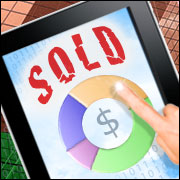
Sales forecasting never has been easy, and over time it has gotten a lot harder. This brings up a couple of points that every sales manager and CEO has to deal with: how to forecast deals and how to track them.
Forecasting has gone through several generations of approaches that have been tied directly to sales practices. Unfortunately, some of us have been reticent to change practices even when the old solutions stop working — but no worries, you can get up to speed quickly.
Where are you on the spectrum below?
1.0 Ad Hoc Forecasting – Spreadsheets
This simply reflects what’s going on in the market. When markets are new and demand outstrips supply, reps can make appointments to take orders. It doesn’t last long, but while it’s happening, you need only enough technology to tally orders and revenue. Listing your deals often shows more revenue than your team can competently deal with, so a simple spreadsheet will suffice.
Making a number is not a problem, because demand is high. It’s easy to move one deal into place if another looks like it’s getting pear-shaped. If this is you today, that’s great — but every market goes through this kind of explosive growth. When the growth slows, you need a different approach.
2.0 Milestone Forecasting – BI
When demand slows, you see a need to manage the forecast, and you’ll probably find that a spreadsheet is insufficient for the job. Deals move in and out, quantities and products change, based on myriad factors, and there are a lot of moving parts.
Spreadsheets become hindrances rather than helpers. When anything changes in a spreadsheet, you have to overwrite what’s there. That leads to the problem of not being able to compare pipeline states between reviews, and with that there’s no way to gauge progress.
Add to this the idea of pipeline milestones and you can begin to have real problems. Reps don’t always adhere to your process. Even if they do, the milestones represent where you are in YOUR process, not necessarily where the customer is, and that can lead to problems.
With so-called milestone forecasting, you can get snapshots of CRM opportunities sorted by sales stage, rep and preassigned probabilities. Rarely do the snapshots add up to a whole picture, though, and many people experience the feeling that everything is out of control, so some turn to business intelligence solutions to give them a fix on the pipeline.
If you need to find the proverbial needle in a haystack, BI is your weapon of choice. Modern BI tools like Tableau, Domo, Birst and GoodData are great for sifting through the reams of customer data to identify correlations — but not necessarily to help determine causation. The difference? BI can tell you that most people buy X when they buy Y, so it’s a good tool for perhaps identifying cross-sell and upsell opportunities.
However, selling is a forward-looking activit — that’s why it’s called a “forecast,” after all — and BI won’t give you the kind of guidance you need to close a deal with a new prospect. Probability-based forecasting will.
3.0 Probability-Based Forecasting – Machine Learning and Data Science
No one can know the future to a certainty, but we can make predictions based on statistics. Handicapping a horse race is a mathematical exercise in looking at relevant factors like race conditions, innate speed, the jockey’s talents, starting position and much more.
By weighting factors and using statistical methods, we can assign probabilities to the whole field. Handicappers are never perfectly right, but their efforts help inform us about how best to deploy limited resources.
Some people might not like the comparison of a sales forecast with horse racing or other games of chance — but those games and some very smart mathematicians, going back hundreds of years, gave rise to modern statistics.
In its purest sense, a forecast uses a statistical model of reality to determine a probability of something happening. The probabilities range from 0.1 (highly unlikely) to 0.9 (highly probable, but not automatic) and the better your model, the more accurate your forecast.
Probability is the heart of modern sales forecasting. The model you need is found in your CRM data of successful deals, as well as deals that you lost. Rather than using calculators, paper and spreadsheets, modern modeling happens with intelligent algorithms that adjust as new information is presented. With probability-based forecasting, it’s easy to input your current sales data and then use what-if scenarios to optimize your projected outcome.
So, for instance, suppose your model indicates that if you maintain your current strategy, you will hit only 80 percent of your goal. However, you also know that some deals have a higher chance of closing if you apply more or different resources — maybe your CEO calls their CEO. Whatever.
With machine learning and data science, you can apply those resources to see if they help or hurt your projection. Either way, you are fine-tuning your tactics based on sound strategy, and it gives you a better idea of what will work best under the circumstances.
The machine learning space is heating up, with companies like Aviso, Clari and Fliptop each using different data science approaches to help sales leaders make sales predictions.
In Conclusion
Most markets are a long way from the easy days of explosive growth. Customers are more demanding, competition is fierce, and trying to close deals with older forecasting approaches is like driving blindfolded.
With a modern approach using machine learning and data science, sales people can reclaim some of the certainty about their forecasts that was routine in earlier eras. To continue the car analogy, machine learning is more like riding in a Google car.
It all starts with a well-defined sales process that can be modeled to produce probabilities. This approach can put some fun back into selling and more commissions in your pocket.





















































